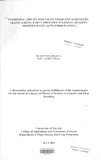| dc.description.abstract | Quality protein maize (QPM), a bio-fortified form of maize has twice the content
of limiting amino acids, lysine and tryptophan, compared with conventional maize. It has
been developed to, among other uses, help alleviate human malnutritition in areas where
protein deficiency is a major problem in diets as in the dry areas of Eastern Kenya.
Information about how F 1 hybrids produced from early drought tolerant QPM inbred
lines compare with one of the popular QPM single-cross (CMLI44/CMLI59) is likely to
speed up release of early drought tolerant QPM cultivars in this area. Prior knowledge on
the combining ability of these inbred lines would be beneficial to breeders in deciding
how to best develop single-crosses, three-way, double-cross hybrids and synthetic
varieties. The objectives were to (i) compare grain yield and agronomic performance of
F 1 hybrids produced from early drought tolerant QPM single-crosses with a reference
QPM check (CMLI44/CMLI59); (ii) estimate general combining ability (GCA) and
specific combining ability (SCA) among early drought tolerant QPM inbred lines for
grain yield and other agronomic traits; (iii) assess the relative importance of general
combining ability and specific combining ability in determining the progeny performance
of the early drought tolerant QPM inbred lines; (iv) to predict grain yield of three-way
and double-cross hybrids from data obtained from the early drought tolerant singlecrosses;
and (v) to establish the relationship between grain yield and other agronomic
traits. Fourteen inbred lines were crossed in half diallel mating design. The 91 diallel
hybrids together with 18 experimental checks and one reference check were planted in
one trial and evaluated in five environments in Kenya including under four optimum and
one drought condition. Data on grain yield, time to anthesis, time to silk, anthesis-silking
interval, ears per plant, root lodging, stalk lodging, ear rots and ear aspect were recorded.
The experimental checks yielded more grain than the diallel hybrids. One diallel hybrid
entry 3 and one experimental check entry 72 had higher grain yields and were earlier in
maturity than the reference check. The combined analysis of variance showed that the
mean squares due to genotypes and general combining ability (GCA) were significant
(p<O.OOl) for all the eight traits studied. However, the mean squares due to specific
combining ability (SCA) was significant (p<O.01) for anthesis date only. Inbred Line 4
had superior GCA effects for grain yield. It was indeed a parent to twelve single-crosses
among the selected top performing, dominant male parent to all the best predicted threeway
hybrids and common parent to all the double-cross hybrids confirming its superiority
in GCA effects. The same inbred had good GCA for shorter anthesis- silking interval,
good alleles for increased number of ears per plant, resistance to ear rots and good ear
aspect. Inbred Lines 5, 12, 7 and 9 had good alleles for reduced anthesis date. Line 6 and
10 had good alleles for root lodging and stalk lodging. Additive gene action appeared to
have been more important than non additive gene action for grain yield and the other
agronomic traits. Average grain yield for the single-crosses, predicted three-way and
double-crosses was found to be the same, suggesting that the grain yield of the singlecrosses
may accurately reflect grain yield of the three-way and four-way crosses and
should therefore be confirmed in field evaluations. An increase in grain yield was
associated with a reduction in anthesis-silking interval and barrenness, and better ear
aspect in the set of inbred lines used in this study. | en |

